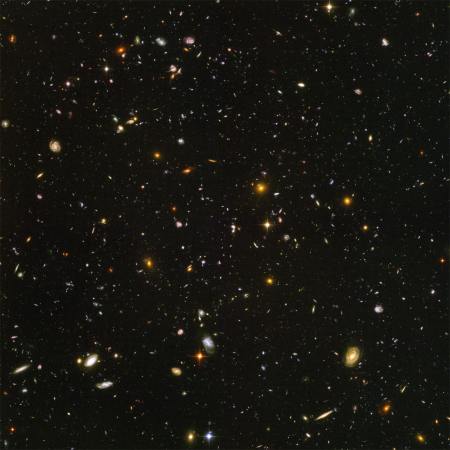Called the Hubble Ultra Deep Field (HUDF), astronomers selected a small swatch of the sky for observation between September 24, 2003, and January 16, 2004. If plotted on a star chart, the area the HUDF looked at lies just south of the constellation Eridanus in the constellation Fornax. The images reveal objects at the edge of the so-called “Dark Ages,” a period between 400 and 800 million years after the Big Bang when the first stars began to reheat the universe. The HUDF views are the deepest into space ever taken by the HST, and they will remain so until NASA’s James Webb Space Telescope is launched in 2011.
“How far is far, and how do you know when you get there?” asked Space Telescope Science Institute (STScI) director Dr. Steven V. W. Beckwith. “This is the deepest picture we’ve ever taken of the universe, more than 13 billion years ago,” says Beckwith. “This is 10 billion times fainter than the faintest objects that can be seen from Earth,” he adds. The tiny part of the sky was photographed during some 400 Hubble orbits of Earth in a million-second-long exposure. “It would take a million years to see the entire sky at this depth,” Beckwith explains.
What emerge in the pair of images are galaxies comprised of familiar shapes as well as strange, distorted configurations resembling toothpicks or charms on a bracelet. In all, some 10,000 galaxies are contained in the field of view, one-tenth the diameter of the Full Moon. The ACS image also shows what appears to be some galaxies interacting during a period of chaos when the order and structure of the universe was first forming. “This image shows the region about 700 million years after the Big Bang, many candidates for redshift galaxies,” says Dr. Massimo Stiavelli, an associate astronomer at STScI. “Some of these objects are strange, inexplicable,” Stiavelli says. “If you look at the universe without great depth, you lose much detail. With more sensitivity, some views have greater detail.”
The NICMOS image sees even more distant objects than those captured by the ACS. It reveals the farthest galaxies ever seen, some 800 million years after the Big Bang, a redshift of 7. “We may have also detected galaxies that lived at 400 million years after the Big Bang,” said Dr. Rodger Thompson, NICMOS principal investigator. These would be at a redshift of 12. “It is the redshift that makes this interesting!” says Thompson, who added that additional study of the image would be needed to confirm the presence of the earlier objects.
The twin images released on March 9th had been closely held by the Institute, and in fact, all researchers saw the images at the same time — on the date of release. The race is now on to identify features and details on galaxy types and formation patterns in the images. And the public was invited to watch the secrets being revealed. At the American Museum of Natural History in New York, teams from the museum, Columbia University, and Stony Brook University were “racing” to see who would be the first to publish results from their studies of the ACS and NICMOS images — with museum visitors invited to watch over their shoulders.










